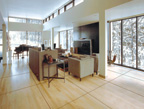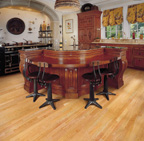


The continued growth of the wood flooring segment has been driven primarily by increasing demand. Consumers continue to look for ways to improve and upgrade their homes, while making them more unique and personalized. They no longer simply want to "keep up with the Jones." They want homes that reflect their personalities. This desire drives the demand for a wider range of species, including exotics from other countries; a wider range of colors including custom stains and finishes; and a wider range of custom installations, including borders, medallions, mixed media and hand scraping.
All of these factors have resulted in higher wood prices. Wood flooring prices are estimated to have increased by 6.7 percent in 2004, while the producer price index rose by 10.7 percent. Despite the higher prices, U.S. consumers continue to increase their use of wood flooring, with the strongest growth occurring in the residential remodeling and residential new construction markets. Both of these markets continue to advance at a record pace.
In an effort to address the issue of rising prices, marketers have shifted sourcing to overseas manufacturers. Last year, distributors significantly expanded the variety of imports they offered, including more woods from Africa and Europe. Imports are estimated to have accounted for 10.5 percent of total U.S. dollars sales in 2004. This is up from 6.6 percent total U.S. dollar sales in 2003.

The jump in imports was primarily led by shipments from Chinese manufacturers. In 2004, imports from China totaled 86 million square feet, representing $109 million (customs value). Theses figures represent 8.3 percent of total U.S. square foot sales, and 4.4 percent of the total U.S. dollar sales. Chinese manufacturers have been able to make these inroads due to their extremely competitive pricing structures. The average selling price for Chinese manufacturers is significantly lower than other wood flooring sold in the U.S.
In response to this issue of increasedcompetition from Chinese manufacturers, a number of U.S. producers have made acquisitions while others have closed plants in order to cut costs. Despite these setbacks, new players continue to enter the market, while existing producers are expanding facilities and product lines due to the average growth prospects for the U.S. wood flooring market.
According to the industry newsletter, Hardwood Review Express, residential housing markets are once again expected to anchor the success of the hardwood market. New home construction for this year is expected to fall short of last year's record level, but not by much. Consumer spending on home remodeling, which accounts for the majority of the hardwood distribution, is expected to continue to set records. In addition, while private residential construction rose by only 0.6 percent to $229 billion in 2004 (well below the U.S. gross domestic product growth rate of 4.2 percent), commercial construction and remodeling activity is increasing rapidly and likely will keep pace with overall economic growth during this year.
Sales gains for hardwood flooring may slow somewhat in 2005 as price increases begin to moderate and housing demand levels off from its current record growth. Still, wood flooring is expected to remain a growing sector of the U.S. flooring business this year and for the next five years as well. As reported at this time last year, wood flooring is expected to remain a growing sector of the U.S. flooring industry during the next five years. U.S. dollar market sales are forecast to climb to $3.4 billion in 2008 and account for 12.8 percent of total dollar floor covering market sales. Quantity market sales are projected to reach 1.3 billion square feet, or 4.3 percent of total U.S. floor demand. Dollar wood sales are forecast to increase at a 9 percent compound annual rate. And quantity market sales are forecast to increase by 5.6 percent annually.
Looking ahead, the industry will continue to experience sales gains in both dollars and square feet, though these gains are expected to level off a bit during the coming year.
Report Abusive Comment